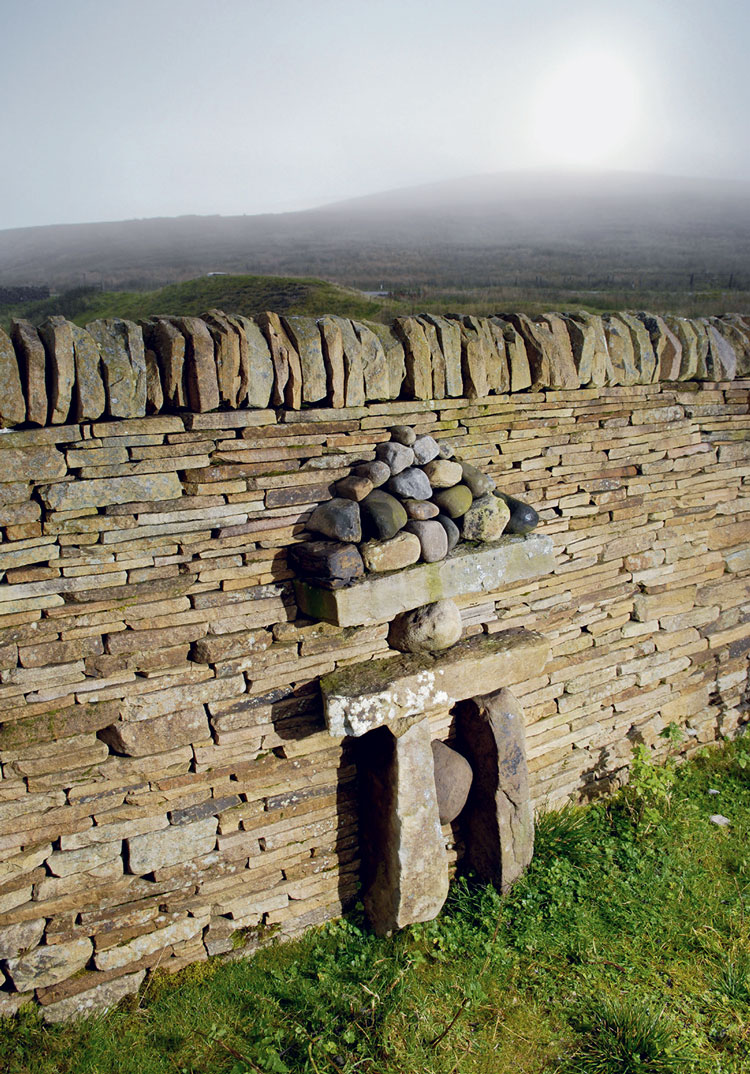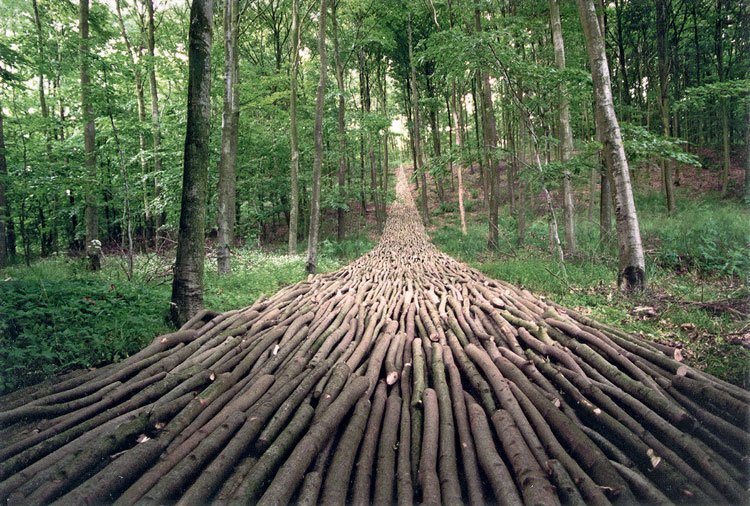
Destination Art book cover; Right: Finn Eirik Modahl. Elektra, 2000. Photo: Lars Lægreid.
reviewed by DAVID TRIGG
There is something perverse about publishing a book on the world’s most inspiring art destinations when international travel is outlawed and most of us are still living under lockdown restrictions. Then again, with museums shut and planes grounded because of Covid-19, perhaps some armchair escapism is just what we need. This is what art historian Amy Dempsey serves up in spades in Destination Art, which introduces readers to permanently sited artworks around the globe, beyond the gallery context – from deserts, forests, mountains and rivers, to ghost towns, nature reserves, quarries and former monasteries. For Dempsey, the artworks are themselves the destination, with location being an integral ingredient. But whether or not one is able to make the journey in person, this engaging volume is a welcome addition to any armchair explorer’s bookshelf.

Ferdinand Cheval, Le Palais Idéal, 1879–1912. Wire, cement, stones,
fossils and shells, 10 x 14 x 26 m (32 x 45 x 85 ft). Photo: Thierry
Ollivier.
Dempsey describes Destination Art as a “grand tour”, alluding to the 17th- and 18th-century aristocratic trend for self-improvement through exposure to the culture of classical antiquity and the high Renaissance. While her 60 destinations host artworks exclusively from the 20th and 21st centuries, the notion persists that there are personal gains to be made by travelling and experiencing art in situ. Why this particular selection of destinations has been privileged over the hundreds of others that could have been included is not disclosed. Neither is it clear whether Dempsey has herself visited every location. Regardless, each of the chronologically arranged entries is accompanied by superb colour photography and an informative text that includes access information and directions – perfect for planning your next visit to one or more of these remarkable land and environment works, expansive sculpture parks or remote site-specific installations.
As you might expect, the book contains several well-known destinations. Donald Judd’s Chinati Foundation in Marfa, Texas, for example, houses a permanent collection of his large-scale installations that are inextricably linked to the surrounding desert landscape. Other obvious choices include Antoni Gaudí’s whimsical Park Güell in Barcelona and Henri Matisse’s Chapel of the Rosary in the town of Vence on the French Riviera. But there are also plenty of lesser-known treats, such as Hannsjörg Voth’s immense rammed earth constructions in a remote corner of the Moroccan desert. Conveying the German artist’s interest in mathematics, astrophysics and mythology, they connect the vast arid landscape to the stars.

Harvey Fite. Opus 40, 1939–76. Bluestone earthwork, 2.6 hectares (6.5 acres). Photo: Philip Scalia/Alamy Stock Photo.
Exploring similar themes is Nancy Holt’s Sun Tunnels (1973-76), located in the Great Basin Desert in north-west Utah. Comprising four enormous concrete pipes that can be walked through, the carefully positioned tunnels frame the sun on the horizon at the winter and summer solstices, while patterns of small holes in their surfaces reference star constellations. Holt, like her husband Robert Smithson (whose monumental Spiral Jetty of 1970 is naturally also included in the book) emerged in the 1960s as a pioneering figure in the Land Art movement. As evinced here, her works aim to foster a deeper appreciation for the natural world and our relationship to the cosmos.

Simon Rodia, Watts Towers, 1921-54. Los Angeles. Concrete, bottles, cups, glass, tile, shells, steel, wire mesh, 1⁄10 of an acre, height of the tallest tower is 99 ½ ft (33.3 m). Photo: CDS Images/Alamy Stock Photo.
The journey to find Holt’s Sun Tunnels is as much of an experience as the destination itself and while many of Dempsey’s choices are similarly located off the beaten track, plenty more are easier to access. Take, for instance, the intriguing Watts Towers that Simon Rodia built in southern Los Angeles between 1921 and 1954. Rodia, an Italian immigrant labourer, constructed the 17 interconnected latticework towers from steel pipe, wire, mortar and concrete, using only simple hand tools. Each one is decorated with multicoloured mosaic made from shards of pottery, tile, glass and shells. His eccentric creation has survived ridicule, a demolition order, riots and earthquakes to become a respected and much-loved LA landmark.
The Watts Towers have been an important source of inspiration for numerous artists, including James Turrell, who greatly admired Rodia’s visionary attitude. Certainly no one can accuse Turrell of lacking vision – the American artist’s most famous project is Roden Crater, an extinct volcano in the Arizona desert that he has spent 45 years transforming into an environment for experiencing and contemplating light, time and the landscape. The project represents the culmination of his lifelong research in the field of human visual and psychological perception and, although it is yet to open to the public, will no doubt be included in future editions of Destination Art. For now, Dempsey has chosen Turrell’s Celestial Vault (1996), a much smaller, artificial crater in the dunes of Kijkduin, a seaside suburb of The Hague. At the centre of the earthwork, which is accessed via a tunnel, a sloping stone bench invites visitors to lie down and experience the illusion of the sky appearing as a vast curved dome.
If you want more bang for your buck, there are plenty of sculpture parks to choose from, including the exceptional Inhotim, a sprawling open-air art museum in the state of Minas Gerais in south-eastern Brazil. Founded by the eccentric mining magnate and art collector Bernardo Paz, this secluded art oasis features nearly 1,000 artworks set amid a landscape of forests, ponds and tropical gardens. Its permanent collection includes international artists such as Olafur Eliasson, Yayoi Kusama and Giuseppe Penone, as well as Brazilians Hélio Oiticica, Cildo Meireles, Lygia Pape and Tunga. Many of the works are displayed outside, with others exhibited across the park’s 23 purpose-built pavilions.

Andy Goldsworthy. River Stone Fold, Deadman Gill (detail), 2002. River stones sourced from Swindale Beck and stone from Keith Bragdon, Swaledale Quarry, overall dimensions of fold: 1.5 x 15.5 x 13.7 m (4 ft 11 in. x 50 ft 10 in. x 44 ft 11 in.); relief sculpture in the fold: 1.4 x 0.8 m (3 ft 5 in. x 2 ft 7 in.) Near Brough, Cumbria. Commissioned by Cumbria County Council, with funds from the Arts Council of England. Photo Rob Cousins/Alamy Stock Photo. © Andy Goldsworthy
Other parks, such as the Tranekaer International Centre for Art and Nature in southern Denmark, place an emphasis on the environment. At Tranekaer, artists are invited to use the rural venue’s natural environment as a site for their works and a source of inspiration and materials. Andy Goldsworthy, David Nash, Alan Sonfist and Lars Vilks have all made work here, with each project reflecting the artist’s profound respect for nature. While some pieces are permanent, others are left to develop a life of their own, evolving and decaying over time. A particular highlight is the Danish artist Mikael Hansen’s Organic Highway (1995/2002/2011), a huge artery of 1,200 sycamore branches flowing through woodland.

Mikael Hansen. Organic Highway, 1995, re-established in 2002 and 2011. Sycamore branches, length 60 m (196 ft 10 in). Photo courtesy the artist.
All the artworks in this book are worth making the journey for. As Dempsey writes in the introduction: “Destination Art is not coming to a museum near you – it is art that you must find and meet in its own space and on its own terms.” For now, of course, that remains impossible. But, as Covid-19 restriction are relaxed, we will again be free to jump on a plane and explore Dempsey’s destinations in person. Yet, with many of the projects emphasising their ecological credentials, we shall need to decide whether the environmental cost of our visit really justifies leaving our armchairs.
• Destination Art by Amy Dempsey will be published by Thames & Hudson on 25 March 2021, price UK £10.99, US $16.95. For pre-orders: bookshop.org